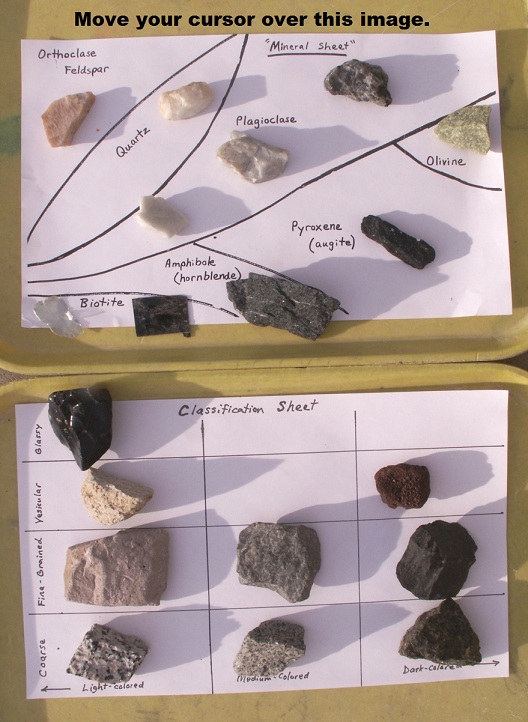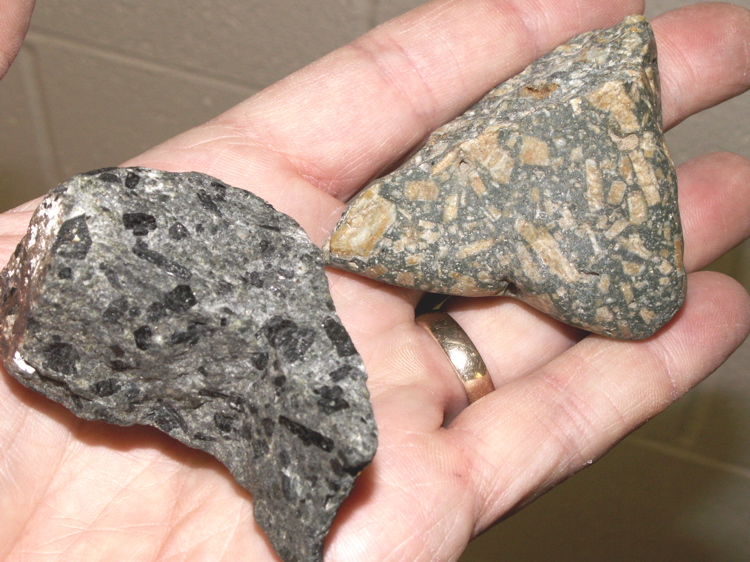|
Classifying Common Igneous Rocks
 Right: This photograph will help you understand the Igneous Rock Lab that we did in class the other day. The tray on top has the common rock-forming minerals and the bottom tray has common igneous rocks. During the activity we classified the igneous rocks according to two criteria; texture (determined by cooling rate) and color (determined by mineral content).
Right: This photograph will help you understand the Igneous Rock Lab that we did in class the other day. The tray on top has the common rock-forming minerals and the bottom tray has common igneous rocks. During the activity we classified the igneous rocks according to two criteria; texture (determined by cooling rate) and color (determined by mineral content). Move your cursor over the image to see the labels.
Color/Minerals . . .
The rocks toward the left side of the tray are light-colored because the minerals they are made of are generally light-colored (quartz, etc.), whereas the rocks on the right are darker colored (augite, etc.). One exception is obsidian. Since it contains plenty of quartz, it is on the left side with other light-colored rocks. As you go from rhyolite to andesite to basalt, you are going from lighter-colored to darker. The same is true as you go from granite to diorite to gabbro.
Texture/Cooling Rate . . .
The rocks in the bottom row (granite, diorite, gabbro are course-grained because they were formed as magma cooled slowly beneath the surface. They are called "plutonic" or "intrusive" igneous rocks. The rhyolite, andesite, and basalt are fine-grained because they were formed as lava cooled much faster above the surface. They are considered to be "volcanic" or "extrusive" igneous rocks. The rocks with vesicular texture (pumice and scoria) are volcanic rocks that formed as gas-filled lava cooled and became rock. The glassy obsidian cooled very quickly.
Same Recipe . . .
Granite and rhyolite are made of the same minerals. If you look at the minerals positioned above them, you will see that they contain plenty of orthoclase feldspar and quartz, as well as some lighter-colored plagioclase feldspar, some biotite, and some hornblende. The difference in appearance (texture) is caused by different cooling rates. The course-grained granite formed as this mixture of minerals cooled slowly over many years beneath the surface (magma), whereas the fine-grained rhyolite formed as a similar combination of molten minerals cooled much faster above the surface (lava). Diorite and andesite also share the same recipe of minerals (look at the minerals located above them) as do basalt and gabbro. CLICK HERE to see a bigger picture of the photo shown on the right.
And then there is porphyry . . .
Shown below are two samples of porphyry (POR-fa-ree), a strange (but fairly common) igneous rock that can be either plutonic (intrusive) or volcanic (extrusive). What makes porphyry unique is that it contains larger crystals (called phenocrysts) surrounded by a matrix of finer-grained rock. This "porphyritic texture" happens when the molten material undergoes two stages of cooling . . . It cooled slowly at first at greater depth, and then the magma moved closer to the surface or onto the surface where it (lava) cooled much faster. The larger crystals formed first as that particular mineral reached its freezing point first when the magma was cooling slower (deeper beneath the surface). These crystals were surrounded by magma (minerals that hadn't reached their freezing points), so the crystals had space to grow. Then the magma moved toward the surface where it cooled much faster, not allowing the remaining minerals enough time to form large crystals. 
| 


